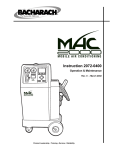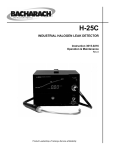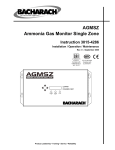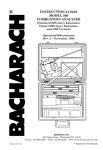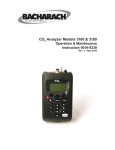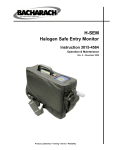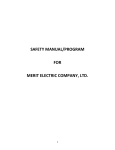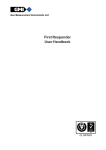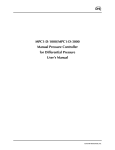Download Bacharach Gas Pup Specifications
Transcript
Gas Pup ® Natural Gas & Pressure Detection Instruction 55-9002 Operation & Maintenance Rev. 1 – December 2003 Product Leadership • Training • Service • Reliability WARRANTY Bacharach, Inc. warrants to Buyer that at the time of delivery this Product will be free from defects in material and manufacture and will conform substantially to Bacharach Inc.’s applicable specifications. Bacharach’s liability and Buyer’s remedy under this warranty are limited to the repair or replacement, at Bacharach’s option, of this Product or parts thereof returned to Seller at the factory of manufacture and shown to Bacharach Inc.’s reasonable satisfaction to have been defective; provided that written notice of the defect shall have been given by Buyer to Bacharach Inc. within one (1) year after the date of delivery of this Product by Bacharach, Inc. Bacharach, Inc. warrants to Buyer that it will convey good title to this Product. Bacharach’s liability and Buyer’s remedy under this warranty of title are limited to the removal of any title defects or, at the election of Bacharach, to the replacement of this Product or parts thereof that are defective in title. THE FOREGOING WARRANTIES ARE EXCLUSIVE AND ARE GIVEN AND ACCEPTED IN LIEU OF (I) ANY AND ALL OTHER WARRANTIES, EXPRESS OR IMPLIED, INCLUDING WITHOUT LIMITATION THE IMPLIED WARRANTIES OF MERCHANTABILITY AND FITNESS FOR A PARTICULAR PURPOSE: AND (II) ANY OBLIGATION, LIABILITY, RIGHT, CLAIM OR REMEDY IN CONTRACT OR TORT, WHETHER OR NOT ARISING FROM BACHARACH’S NEGLIGENCE, ACTUAL OR IMPLIED. The remedies of the Buyer shall be limited to those provided herein to the exclusion of any and all other remedies including, without limitation incidental or consequential damages. No agreement varying or extending the foregoing warranties, remedies or this limitation will be binding upon Bacharach, Inc. unless in writing, signed by a duly authorized officer of Bacharach. To Register Your Warranty, Visit www.bacharach-inc.com Declaration of Conformity Manufacturer’s name: Bacharach, Inc. Manufacturer’ address: 621 Hunt Valley Circle New Kensington, PA 15068-7074 European operations: Bacharach Europe Sovereign House, Queensway Royal Leamington Spa Warwickshire CV31 3JR United Kingdom Product name: Gas Pup conforms to the following specifications: European Directive 89/336/EEC EN 50081-1: 1992 (Emissions) EN 50082-1: 1998 (Immunity) EN 61000-4-2: 1995 (Electromagnet) EN 61000-4-3: 1995 (Electromagnet) Notice: Product improvements and enhancements are continuous, therefore the specifications and information contained in this document may change without notice. Bacharach, Inc. shall not be liable for errors contained herein or for incidental or consequential damages in connection with the furnishing, performance, or use of this material. No part of this document may be photocopied, reproduced, or translated to another language without the prior written consent of Bacharach, Inc. Copyright © 2001-2003, Bacharach, Inc., all rights reserved. BACHARACH® and Pup® are a registered trademarks of Bacharach, Inc. All other trademarks, trade names, service marks and logos referenced herein belong to their respective companies. A Instruction 55-9002 Gas Pup Contents Contents Safety Information ....................................................................... iii Introduction ..................................................................................... 1 General Description ................................................................................ 1 Components ............................................................................................. 2 Natural Gas Detection ....................................................................... 2 Pressure Detection ............................................................................. 2 Sample Pump ..................................................................................... 2 Batteries ............................................................................................. 2 Case ..................................................................................................... 2 Control Panel Description ...................................................................... 3 Gas and Pressure Fittings ...................................................................... 4 Technical Characteristics............................................................. 5 Operation .......................................................................................... 6 Operating Precautions (Please Read) .................................................... 6 Battery Installation ................................................................................. 7 Turning ON the Gas Pup ........................................................................ 8 Turning OFF the Gas Pup .................................................................... 10 Backlighting .......................................................................................... 11 Battery Voltage Check .......................................................................... 11 Gas Operating Mode ............................................................................. 11 Auto-Ranging .................................................................................... 12 Fixed HI% Range .............................................................................. 12 PPM Range ....................................................................................... 13 LO% (Low Percent) Range ............................................................... 13 HI% (High Percent) Range ............................................................... 14 Pressure Operating Mode ..................................................................... 14 Selecting the Pressure Mode ............................................................ 14 High Pressure Mode ......................................................................... 16 Low Pressure Mode .......................................................................... 16 Delta Pressure Mode ........................................................................ 16 Using the Probe’s Filter Chamber ........................................................ 18 Foam Filter Element – Particulate Filtration ................................. 18 Charcoal Filter – Petroleum Vapors vs. Combustible Gases .......... 18 Water/Filter Trap .................................................................................. 20 Error Messages ...................................................................................... 21 Instruction 55-9002 i Contents Gas Pup Calibration ..................................................................................... 22 Gas Calibration Equipment Setup ....................................................... 22 Gas Calibration Procedure ................................................................... 23 Pressure Sensor Check ......................................................................... 27 Maintenance ................................................................................... 28 Batteries ................................................................................................ 28 Sampling Probe ..................................................................................... 28 Gas Inlet Filter Replacement ............................................................... 29 Pump Replacement ............................................................................... 29 Combustibles Sensor Replacement ...................................................... 30 Leak Check Basics ................................................................................ 30 Parts & Service .............................................................................. 32 Replacement Parts ................................................................................ 32 Accessories ............................................................................................. 33 Service Centers ..................................................................................... 34 ii Instruction 55-9002 Gas Pup Safety Safety Safety is essential in the use and maintenance of Bacharach equipment. Therefore this manual and any marking on the instrument provide important safety information concerning the operation, care, and maintenance of this instrument. All operating and maintenance personnel should read and understand the contents of this manual before operating or maintaining the instrument. Observe all of the safety information provided. Safety Alert Symbol This symbol together with the word WARNING or CAUTION is used to call a user’s attention to hazards or unsafe practices that could result in injury or property damage. The message that follows provides information for preventing or avoiding the hazard. WARNING: Informs the user of hazards or unsafe practices that if not avoided could result in severe personal injury or death. CAUTION: Informs the user of hazards or unsafe practices that if not avoided could result in personal injury or property damage. Purpose of Manual This instruction manual is intended to familiarize all personnel with the safe operation and maintenance procedures for the Bacharach Gas Pup. Please retain this manual for future reference. Instruction 55-9002 iii Safety Gas Pup Notes: iv Instruction 55-9002 Gas Pup Introduction Introduction General Description The Bacharach Gas Pup (Figure 1) is a natural gas detection instrument designed for general leak detection, barholing operations, regulator pressure checks, and line pressure integrity operations. It offers measurement of natural gas (as methane) in the following three ranges: • PPM (Low) Range: Gas level displayed in 0 to 2500 ppm as a bar graph, allowing visual indication of the peak reading. Useful for locating leaks in piping. • LO% (Mid Percent) Range: Measures natural gas in the range of 0.2–5.0% by volume, which corresponds to the lower explosive limit (LEL) of methane. Figure 1. Gas Pup shown with Probe and Coiled Tubing • HI% (High Percent) Range: 0–100% by volume is useful in “pin pointing” leaks in underground piping through barhole testing The Gas Pup also features three pressure modes: High (0 to 99 psig); Low (–9.9 to 9.9 psig); and Delta (displays a pressure change in the range of ±9.9 psig from any reference pressure between 0 and 90 psig). Three ‘AA’ batteries power the instrument. Pressing the key for at least 1 second turns the instrument ON; after which, the battery voltage is briefly displayed, followed by the gas and pressure sensors being zeroed, and then followed by the display of the detected gas level. The Gas Pup’s gas display is auto ranging, automatically switching between its PPM, LO%, and HI% ranges as the detected gas level rises and falls. The Gas Pup’s pressure-operating mode is selected by pressing the key while the word “GAS” is being displayed during the instrument’s warm-up period. Instruction 55-9002 1 Introduction Gas Pup Components Natural Gas Detection The instrument’s PPM and LO% ranges use a catalytic-bead detection circuit, which is the most widely accepted method of detecting combustible gases. The HI% range uses the thermal-conductivity method of detection, which is a reliable method for measuring the concentration of one gas in a second gas (methane in air). Pressure Detection The instrument contains a solid-state pressure sensor that supports the instrument’s three pressure modes (High, Low & Delta). The optional Pressure Hose Kit accessory with fittings (P/N 55-0038) can be used to connect the instrument’s quick-connect pressure fitting to the pressure source. Sample Pump An internal sample pump draws a gas sample into the instrument for analysis. This is a convenience in the LO% and HI% gas ranges, providing a more reliable and accurate test of gas levels. It is also important in the PPM range to achieve a stable gas reading at low gas concentrations. The sample pump includes a flow-failure function. If the flow is blocked (e.g., clogged filter or crimped hose), the display will blink the letters “F P” in the READING window. When the pump returns to normal operation, the display stops blinking. Batteries Three ‘AA’ alkaline batteries supply power to the instrument. A fresh set of batteries will typically last 6–8 hours, depending on how the instrument is used. The batteries are housed in a battery block internal to the instrument, and are protected with a metal cover and retained by two thumbscrews. This design allows the batteries to be quickly replaced in an area known not to contain explosive gases. Case The instrument is housed in an anodized extruded aluminum case. The instrument is rugged, resistant to water and electromagnetic interference. Rubber-bumper guards provide impact protection on both ends of the instrument. 2 Instruction 55-9002 Introduction Gas Pup Control Panel Description Two pushbutton controls and a large LCD are conveniently located at the top of the instrument. The backlit LCD provides highly readable indications of natural gas or pressure in any lighting condition ranging from direct sunlight to total darkness. The control panel consists of the following three windows and two pushbutton keys: • READING Window: A two-digit display that is used to primarily display the concentration of natural gas in the LO% and HI% gas ranges. The READING window also displays pressure readings when the instrument is operating in any one of its three pressure modes. RANGE Window (range pointer showing that instrument is in its HI% range) READING Window (showing 25% gas) Range Identifiers Bar Graph Window (active only in the HI% and ppm ranges, showing 25% gas) Power ON/OFF Key, plus Backlight ON/OFF Function Key Figure 2. Controls and Indicators Instruction 55-9002 3 Introduction Gas Pup • Bar Graph Window: Provides a real time moving display of the natural gas concentration to give a better ‘feel’ of when the gas level has reached a peak. The bar graph is active only in the PPM and HI% ranges. • RANGE Window: Identifies the range in which the instrument is currently operating. This is accomplished by means of a pointer, which in conjunction with range-labels printed on the display overlay, define a range for the gas reading. • Key: Turns the instrument, and also the backlight, ON and OFF. • Key: Changes the instrument’s function as determined by its current operating mode, thus allowing a variety of functions to be selected with just one pushbutton. Refer to text in this manual’s Operating section for details. Gas and Pressure Fittings Two quick-connect fittings (Figure 3) provide convenient connections to the gas probe and pressure hose assemblies. The gas fitting mates with a quick-connect female plug, while the pressure fitting mates with a quick-connect male plug. Gas Fitting Pressure Fitting Figure 3. Gas and Pressure Fittings 4 Instruction 55-9002 Gas Pup Technical Characteristics Technical Characteristics Measurement Ranges: Natural Gas ........................... PPM: 0 to 2500 ppm LO%: 0.2 to 5.0% volume gas HI%: 0 to 100% volume gas Pressure: High .................................... 0 to 99 psig Low ...................................... ±9.9 psig referenced to atmospheric pressure Delta .................................... ±9.9 psig from any reference pressure point between 0 and 90 psig Accuracy: Natural Gas ........................... PPM: (not applicable) LO%: ±0.3% gas HI%: ±3% gas Pressure: ................................ ±5% of Reading Warm Up Time ........................ 1 minute Response Time: Gas.......................................... <20 seconds to 95% of final value Pressure ................................. <5 seconds to 95% of final value Operating Environmental Conditions: Temperature .......................... –4 to 122 °F (–20 to 50 °C) Humidity ................................ 10 to 95% R.H. (non-condensing) Air Pressure ........................... 1 Standard Atmosphere, ±10% Position .................................. Any Storage Environmental Conditions: Temperature .......................... –22 to 122 °F (–30 to 50 °C) Humidity ................................ 10 to 95% R.H. (non-condensing) Position .................................. Any Size ............................................ 4.7 x 2.3 x 3.7 in. (11.9 x 5.8 x 9.4 cm) Weight ...................................... 25 oz (712 g) Batteries .................................. Qty 3, ‘AA’ alkaline Battery Life ............................. Typically 6–8 hours of continuous operation, and well over a week of operation when used from 50 to 60 minutes a day Agency Approvals ................. MET lab certified to UL913 and CSA C22.2-157, intrinsically safe for use in Class I, Division 1, Groups A, B, C & D hazardous areas Instruction 55-9002 5 Operation Gas Pup Operation Operating Precautions (Please Read) To ensure that the gas sensor is properly zeroed at startup, the Gas Pup must be turned on in fresh air (free of combustible gases or vapors). Before using the Pup to detect gas, ‘bump test’ the instrument by applying a known concentration of gas to the instrument’s gas inlet port, and then observing that the instrument responds to the applied gas in a positive manner. The optional Response Check Gas bottle (P/N 51-1816) is recommended for this purpose. Calibrate the instrument about every 30 days to assure its accuracy. The frequency of calibration, however, may change depending on how often the instrument is used and the amount of gas that was sampled. Create a maintenance log to keep track of when an instrument was calibrated, and then use this log to help develop a calibration schedule. For example, an instrument that fails its calibration after only being calibrated a single time should be calibrated more often. Avoid sampling leaded gasoline vapors, or gases or vapors containing silicones or sulfur compounds. Tetraethyl lead, silicones, and sulfur compounds can form contaminating compounds on the sensor element (poison the sensor), with resulting loss in sensitivity. Always purge the instrument with fresh air after completing a test. This removes combustibles from the sensor chamber and prolongs the life of the sensor. 6 Instruction 55-9002 Operation Gas Pup Battery Installation WARNING: Explosion hazard: • To reduce the risk of igniting a flammable atmosphere, batteries must only be changed in an area known to be non-flammable. • To maintain agency approval, use only the following types of ‘AA’ alkaline batteries: Energizer E91; Duracell MN1500 or MX1500; Rayovac 815; and Panasonic AM-3PI. 1. Loosen the two thumbscrews on battery cover and remove cover. 2. Insert three ‘AA’ batteries into the Pup, observing polarity as shown in Figure 4. 3. Reinstall battery cover and tighten its thumbscrews. LOOSEN BOTH BATTERY COVER THUMBSCREWS ‘AA’ BATTERIES Figure 4. Battery Installation Instruction 55-9002 7 Operation Gas Pup Turning ON the Gas Pup Important! To assure that all detectors are properly zeroed, the Gas Pup must be turned on in a gas-free environment (no combustibles), and that no pressure is being applied to the instrument’s pressure port. It is also recommended that the probe and hose assembly be connected to the instrument before turning it on. Refer to Figure 5. The Gas Pup is turned ON by momentarily pressing the key for 1 second. Listen for the pump to start and observe that all segments of the display are momentarily turned on. After all segments have been displayed the word “UEr” (Version) is displayed followed by the instrument’s software version number. Next, the letter “b” appears in the RANGE window along with the battery voltage momentarily appearing in the READING window. The instrument will quickly move to display the word “GAS”, indicating that the instrument is operating in its gas mode. After several seconds, the READING window will display a flashing “AS” (Auto Start). This is the Auto Start portion of the instrument’s operation, and is used to stabilize the gas sensor in order to establish ‘zero’ gas readings. Without additional operator intervention, the auto start portion of the start-up routine will finish, leaving the instrument in its PPM gas range. 8 Instruction 55-9002 Operation Gas Pup LCD Segment Test Software Version UEr (Version) Battery Voltage RANGE Mode Display Flashing Display / Auto Start Sequence PPM Gas Display Figure 5. Turning ON the Gas Pup Instruction 55-9002 9 Operation Gas Pup Turning OFF the Gas Pup Pushing and holding down the sequence. key initiates the instrument’s turn-off At first the battery voltage is displayed, followed in about 1 second by the letters “OFF” scrolling across the screen. The screen will go blank shortly after all three letters are displayed. Release the key as soon as the display goes blank. Press and hold down button Release button when OFF disappears Figure 6. Turning OFF the Gas Pup 10 Instruction 55-9002 Operation Gas Pup Backlighting Backlighting of the LCD allows a user to see the display in darkened areas. Be aware that backlighting causes a higher battery drain and should only be used when needed. To conserve battery life, the backlight is automatically disabled when the battery voltage falls below 2.2 volts. key. The backlight will turn To activate the backlight, briefly press the ON along with the battery voltage being displayed for about one second. The backlight automatically turns OFF after 5 minutes, or it can be immediately turned off by again briefly pressing the key. Battery Voltage Check Battery voltage can be displayed by briefly pressing the this action also turns on the backlight. key. Note that Battery voltage is displayed in terms of the voltage available at the printed circuit board from the battery source. The nominal voltage ranges from approximately 2.8 volts to a minimum of 1.9 volts. Although the Gas Pup will operate down to 1.9 volts, the last portion of the voltage curve is quite steep. It is recommended that, except for short tests, the batteries be replaced when the reading drops to less than 2.0 volts. Gas Operating Mode This is the default operating mode when no mode selection is made at startup. With the probe and hose assembly connected to the Gas Pup’s gas inlet fitting, begin checking for gas by placing the probe tip into the area to be tested. Wait approximately 15 seconds, and then observe the detected gas level on the instrument’s LCD. The Gas Pup will display the detected gas level in one of three ranges: PPM (0–2500 ppm), LO% (0.2–5.0%), and HI% (0–100%). WARNING: Explosion hazard. Should the display indicate a gas reading near 5% (equivalent to 100% LEL), the instrument is sampling from an area with a potentially explosive concentration of gas. Take all necessary precautions to prevent ignition. Also, if the detected gas concentration is above 15%, which is normally considered too rich to be explosive, the concentration around the area sampled may be within the explosive range and should be considered dangerous. Instruction 55-9002 11 Operation Gas Pup After checking for gas, allow the instrument to sample fresh air until the LCD shows a very low ppm reading. This will help prolong sensor life by purging the sensor chamber of combustible gas. Auto-Ranging The Gas Pup incorporates an auto-ranging function that automatically switches the display between ranges when a range limit is reached. This avoids manual switching, and assures, in conjunction with the range display, that accurate readings are provided at all times. The range selected by the instrument is indicated by a pointer that appears in the RANGE window (see Figure 7). When a reading in the PPM range exceeds 2,500 ppm (equal to 0.25% by volume, bar graph at full scale), the display will automatically switch to the LO% range, covering from 0.2% to 5.0%. This change will be instantaneous. But if the reading is close to 2,500 ppm, observe that the display may flicker between ranges for a few seconds. HI% LO% PPM Range PPM RANGE HI% LO% LO% Range PPM RANGE HI% LO% HI% Range PPM RANGE Figure 7. Range Display When the LO% reading exceeds 5.0%, the display automatically transfers to its HI% range. This transfer takes a few seconds to allow the detector to stabilize in the new range. Auto-ranging from HI% to LO% occurs when the reading falls below 5.0% for more than 5 seconds. The 5-second delay is to prevent nuisance range transfers. Fixed HI% Range Manual selection of the HI% range may be made to avoid any delay caused by auto-ranging (for example in barhole testing), and to retain the highest reading shown on the bar graph. To lock the instrument in its HI% mode, momentarily press the key. Once auto-ranging has been overridden, the instrument will remain in the HI% range until the key is pushed again. 12 HI% LO% HI% Range PPM RANGE Figure 8. Fixed High Range Instruction 55-9002 Gas Pup Operation PPM Range After the Gas Pup has been turned on, it will default to its PPM range, showing nothing or some portion of a bar graph display. The range window will show a pointer to the “PPM” flag for range definition. Any low levels of gas will be shown by a moving bar graph, which is logarithmic providing a much higher response at the low end of the scale. No numerical display is provided in this range, as its primary purpose is to locate a small leak rather than to measure a gas concentration. Full scale on the PPM range is 2,500 PPM or 0.25% by volume. 500 PPM is about mid-scale, while 1,000 PPM is about ¾ scale. Figure 9. Typical PPM Reading Showing 500 PPM LO% (Low Percent) Range When the gas concentration increases beyond the upper limit of the PPM range, the display automatically switches (autoranges) to the LO% range, showing a twodigit value with one decimal place. This range of the instrument is used for detecting gas concentrations that may approach the explosive level. Natural gas may cause an explosion if the concentration is around 5% by volume in air. This is referred to as Figure 10. the Lower Explosive Limit (LEL) of gas, Typical LO% Reading and represents an extreme hazard. The Showing 2.5% Gas range indicator points to the “LO%” flag for range definition. The reading will track current concentration with a numerical-only display. This approach is used to provide a numerical readout where readings are significant and documentation of readings may be required. Auto switching from PPM to LO% is instantaneous. Switching from LO% to PPM, however, may be accompanied by the display momentarily flickering between the bargraph-only display (PPM range), and the numerical-only display (LO% range). This flickering should be brief. Instruction 55-9002 13 Operation Gas Pup HI% (High Percent) Range If the gas concentration goes above the upper limit of the LO% range (greater than 5.0%), automatic changeover to the HI% range occurs. The instrument goes through a 5 second stabilization time period after this range change occurs, with the display flashing as an indication that the readings are inaccurate until stabilized. 38% Gas In the HI% range, there is a two digit numerical display, with no decimal point, plus a bar graph that tracks the digital reading. The range indicator points to the “HI%” flag for range definition. The number displayed is the concentration of natural gas being sampled in steps of 1% by volume. Note that because there is only two digits, 100% gas is displayed as “– –”. The bar graph tracks the digital reading to give an enhanced visual picture of the changing gas concentration, but the highest bar ‘sticks’ at the maximum reading. 100% Gas As noted above, a unique feature of the HI% range is that the bar graph ‘sticks’ at the maximum reading, a convenience in barhole testing where the peak value is desired. This peak value is retained until the instrument transfers (automatically or manually) to the LO% range. Figure 11. Typical HI% Reading Showing 38% Gas and 100% Gas Pressure Operating Mode Selecting the Pressure Mode See Figure 12. The instrument is placed in its pressure mode by pressing the key during startup while the word “GAS” is displayed. The display changes to “PrS” to indicate that the pressure mode has been selected. Then after the instrument warms up, the letter “P” appears in the RANGE window, indicating that the instrument is currently measuring pressure. 14 Instruction 55-9002 Operation Gas Pup Important! Ensure that the instrument’s pressure port is open to the atmosphere during startup, otherwise incorrect pressure readings may result. Before making a pressure measurement, tubing must be connected between the gas source and the instrument’s pressure port. Depending on the application, use the tubing and hardware supplied in either the optional Pressure Hose Kit (P/N 55-0038) or Service Line Pressure Testing Kit (P/N 55-0072) to make this connection. Refer to the Accessories section of this manual for a description of these options. Figure 12. Selecting the Pressure Operating Mode During Startup Instruction 55-9002 15 Operation Gas Pup High Pressure Mode CAUTION: Maximum over pressure without damage is 150 psig. The high-pressure mode measures pressure in the range of 0 to 99 psig. Enter this mode by first selecting the pressure mode during startup as previously described. The instrument will default to its high-pressure mode as signified by the letter “P” appearing in the RANGE window. The READING window will display the pressure applied to the instrument’s pressure port. Note that an outof-range pressure condition is signaled by two dashes “–.–” appearing in the READING window. Typical High-Pressure Reading Low Pressure Mode The low-pressure mode measures pressure in Typic Low-Pressure the range of 0 to 9.9 psig, and also negative Reading pressures down to –9.9 psig. Enter this mode by first placing the instrument into it highFigure 13. High & Low pressure mode as previously described. Then Pressure Modes press the key to switch to the low-pressure mode as indicated by the letter “d” appearing in the RANGE window. The READING window will display the pressure applied to the instrument’s pressure port. Positive pressure readings are indicated by a steady display, while negative pressures are indicated by a flashing display. Note that an out-of-range pressure condition is signaled by two dashes “–.–” appearing in the READING window. Delta Pressure Mode The delta pressure mode is used to measure the delta (difference) in pressure, and is useful when pressure proving new or repaired piping that has been pressurized with compressed air. Do the following to pressure prove a piping system (see Figure 14): 1. Attach the components of the optional Service Line Pressure Testing Kit (P/N 55-0072) between the piping being tested and the instrument’s pressure port. 2. Set up the Pup to measure high pressure as previously described under the heading High Pressure Mode. 16 Instruction 55-9002 Operation Gas Pup 3. Attach a hand pump or air compressor to the tire-valve portion of the Testing Kit’s Tee, and then pump up the system to the desired pressure (not to exceed 99 psig). key until the letter “d” appears in the RANGE window, 4. Press the indicating that the Gas Pup is now operating in its delta pressure mode. The value “0.0” should now appear in the READING window, indicating that the pressure being measured equals the high-pressure reading just taken. Note: The delta and low-pressure modes are activated in the same manner. The difference being that the low-pressure mode is entered while the instrument’s pressure port is open to the atmosphere, while the delta mode is entered with pressure already applied to the instrument. 5. Monitor the value in the READING window. The value displayed indicates the difference in pressure (in the range of ±9.9 psig) between the current reading and the initial pressure measurement. Positive pressure readings, probably due to a rise in temperature, are indicated by a steady display, while negative readings that are due to leaks are indicated by a flashing display. Note that an out-of-range pressure condition is identified by two dashes “–.–” appearing in the READING window. To piping system being tested Attach a hand pump or air compressor and pump up piping system to desired pressure (not to exceed 99 psig) with instrument in its high-pressure mode PRESSURE FITTING SERVICE LINE PRESSURE TESTING KIT P/N 55-0072 ® NATURAL GAS HI% LO% PPM READING RANGE Figure 14. Pressure Proving a System using the Delta Pressure Mode Instruction 55-9002 17 Gas Pup Operation Using the Probe’s Filter Chamber The standard 10" probe supplied with the Gas Pup has a built-in filter chamber that can hold either a foam filter element, or a charcoal filter pack. Install and use these filters as follows: Foam Filter Element – Particulate Filtration When sampling, it is good practice to keep a foam filter installed inside the probe’s filter chamber (see Figure 15). Although the instrument’s gas inlet already has an internal particulate filter, the probe’s foam filter will prevent dirt particles from building up inside the hose, which could eventually cause a flow restriction, and where the dirt particles would be difficult to remove for cleaning. Filters are packed ten to a box, and are available as P/N 5500-7100. Figure 15. Foam Filter Element Charcoal Filter – Petroleum Vapors vs. Combustible Gases By using a disposable charcoal filter pack, it is a simple matter to distinguish between an indication caused by combustible gases (from a pipeline leak, for example) or an indication caused by a source of petroleum vapors (such as a nearby gasoline station). Activated charcoal will absorb a portion of the petroleum vapors in a gas sample; however, it will allow a dry combustible gas (such as natural gas or propane) to pass through. Filters are packed ten to a box, and are available as P/N 5500-7400. 18 Instruction 55-9002 Operation Gas Pup The petroleum absorbing property of the activated charcoal filter is used to detect petroleum based gases and vapors in the following way: 1. With a standard foam filter installed in the probe’s filter chamber, take a gas sample and note the display indication. 2. Remove the foam filter and install in its place one of the small activated charcoal filter packs. See Figure 16. Note: The charcoal pack will increase the response time of the instrument. Therefore, draw a sample of gas through the instrument for at least 60 seconds before taking a reading. 3. Take a second gas sample from the same area, and note if the indication is less than it was in Step 1. If the indication has dropped, this means that the charcoal has probably absorbed petroleum vapors, and that one cause of the lower indication is likely to be petroleum vapors. WARNING: Following the use of a charcoal filter pack, the pack should be removed from the probe and discarded. Otherwise, the presence of combustible vapors may not be detected in subsequent testing. Figure 16. Charcoal Filter Pack Instruction 55-9002 19 Gas Pup Operation Water/Filter Trap The optional water/filter trap accessory is recommended to be used in conjunction with the 30" barholing probe; thus preventing water from being drawn into the instrument when the probe is inserted into a hole filled with water. The water trap can also be used with the standard 10" probe when an operator is probing for a gas leak in an area that contains pools of water. Install the water/fiter trap directly on the instrument’s gas inlet fitting; then connect the gas probe and hose assembly to the water trap as shown in Figure 17. When using the water trap, observe that its bowl will begin to fill as water is drawn into the probe. It is good practice not to allow the water level to rise above the filter retainer. Empty the bowl by first turning OFF the Pup or removing the water/filter trap from the instrument, and then pushing up on the drain valve located at the bottom of the bowl. The water trap also contains a particulate filter that should be changed when it becomes contaminated with dirt. Note that a dirty filter will slow down the flow of gas into the instrument and thus slow down the instrument’s response time. Replace this filter by first unscrewing the bowl, and then unscrewing the filter retainer and discarding the old filter. Install a new filter and reattach the bowl. Attach Water/Filter Trap to the Instrument’s Gas Inlet Fitting Gas Probe & Hose Connector PARTICULATE FILTER (P/N 07-1644) BOWL (It is good practice not to allow the water level to rise above the Filter Retainer, otherwise gas flow may become restricted.) FILTER RETAINER DRAIN (Do not drain bowl with Pup turned ON, otherwise water may be drawn up into the instrument.) Figure 17. Water/Filter Trap 20 Instruction 55-9002 Operation Gas Pup Error Messages The following is a list of error messages that may appear when operating the Gas Pup. Note that numerical messages appear just prior to the instrument turning itself off. Contact your nearest Bacharach Service Center for assistance if the suggested remedies do not restore the instrument to normal operation. Error Messages Meaning Remedies 2.3.0. Stable level of calibration gas Ensure that a sufficient was not detected within 50 amount of calibration gas seconds during calibration. is being applied. 2.3.1. Calibration gas was not detected during calibration. Apply calibration gas when required. 2.3.2. Gain increase since last calibration was greater than 50%. Replace combustibles sensor. 2.4.2. Zero offset point for sensor is too low. Replace combustibles sensor. 2.4.8. Failure to write calibration value to EEPROM. Return instrument to Bacharach for repair. 2.5.1. Instrument failed to zero the combustibles sensor within 4 minutes. Replace sensor. 2.5.2. Low-battery condition. Replace batteries. FP Pump not running at proper speed. Blocked or insufficient gas flow through instrument due to a pinched hose or clogged inlet filter (see Fig. 23). Instrument may be too cold. CAL Instrument not calibrated. Calibrate instrument. Instruction 55-9002 21 Gas Pup Calibration Calibration It is recommended that the Gas Pup be calibrated by your nearest Bacharach Service Center. Calibration, however, can be performed in the field if your facility has the necessary equipment and qualified personnel to perform the procedures described in the following sections. Gas Calibration Equipment Setup The following equipment is recommended to calibrate the Gas Pup (refer to the Accessories Section for part numbers): • Calibration Kit (includes gas regulator, tubing, and instrument fitting) • Calibration Gas: - Zero Air (20.9% Oxygen, balance Nitrogen) (optional) - 2.5 ±0.05% methane - 100 ±2% methane WARNING: If you are not using Bacharach’s calibration kit, be sure not to apply pressure to the gas inlet from your own calibration equipment. Use the excess flow calibration method, otherwise incorrect gas readings may occur. Connect the components of the calibration kit, calibration gas cylinder, and Gas Pup together as shown in Figure 18. DO NOT connect the Gas Inlet Fitting to the Pup until instructed to do so in the calibration procedure. ON-DEMAND GAS REGULATOR * TUBING* GAS INLET FITTING * (Do not connect until “AC” is displayed in READING window) CALIBRATION-GAS CYLINDER 2.5% or 100% Methane (See Accessories Section for Part Numbers) ® NATURAL GAS HI% LO% PPM READING RANGE *Part of Calibration Kit Figure 18. Calibration Equipment Setup 22 Instruction 55-9002 Calibration Gas Pup Gas Calibration Procedure The Gas Pup has an auto-calibration feature that ensures proper calibration of the instrument. After setting up the calibration equipment as previously described, proceed with the calibration procedure as follows: 1. Before turning ON the instrument, be sure that the calibration equipment is not connected to the instrument, and that the instrument is in an area of fresh air. Important! Calibration should be performed in an area of fresh air. If the quality of the surrounding air is unknown, then zero air should be applied to the instrument's gas inlet port before the instrument is turned on and allowed to flow during the auto-start sequence (flashing “AS” in the READING window). This will require a second regulator to be connected to a zero-air cylinder. 2. Press the key to turn ON the Pup. Before proceeding to Step 3, wait until the instrument enters its auto-start period (flashing “AS” appears in the READING window). 3. See Figures 19 and 20. Auto calibration is started by pushing the key at any time while “AS” is being displayed. Observe that the letter “C” appears in the RANGE window, indicating that the instrument is ready for calibration at the conclusion of the auto-start sequence. Calibration gas must not be supplied to the instrument before this time, or the sensor’s zero setting will be in error. 4. Following the auto-start period, the instrument will display a steady “AC” for about 10 seconds and display “L” (for LO%) in the RANGE window. The default range is LO% (Figure 19), but if you are calibrating the HI% range (Figure 20), then press the key until “h” is displayed. WARNING: In the following steps, be sure to apply the correct concentration of gas for the range being calibrated as listed below. Failure to apply the correct gas will cause inaccurate gas readings. • LO%: apply 2.5% gas while showing “L” in the RANGE window • HI%: apply 100% gas while showing “h” in the RANGE window Instruction 55-9002 23 Gas Pup Calibration Note: If zero air is being applied at this time, remove it before proceeding to Step 5. 5. While a steady “AC” is being displayed, apply calibration gas by simply connecting the tubing from the calibration equipment to the Pup’s gas-inlet fitting. The on-demand gas regulator will automatically begin to supply the correct amount of calibration gas to the instrument. 6. As the calibration gas is being applied, “AC” will begin flashing until a steady gas value is detected for a period of 5 seconds, after which the display will change to the calibration setting (2.5% for the LO% range, or 100% for the HI% range). At this time the calibration gas may be removed. The instrument’s programming contains safeguards to prevent inaccurate calibration, or to limit the use of a sensor that may require replacement due to imminent failure. Should calibration gas not be applied within the calibration period of 10 seconds, the instrument will drop out of the autocal mode and turn off (error code 2.3.1 is displayed just before the instrument turns off). The instrument is turned off to attract the users attention and make it evident that a proper calibration had not been achieved. The prior calibration values will be maintained to prevent an unintended change to these values. 24 Instruction 55-9002 Calibration Gas Pup Flashing Display Flashing Display Steady Display Apply 2.5% gas now Fashing Display During Calibration Remove gas Figure 19. Performing a LO% Calibration Instruction 55-9002 25 Gas Pup Calibration Flashing Display Flashing Display Flashing Display Steady Display Apply 100% gas now Flashing Display During Calibration Remove gas Figure 20. Performing a HI% Calibration 26 Instruction 55-9002 Calibration Gas Pup Pressure Sensor Check The pressure sensor does not require calibration, but it is recommended that the sensor be checked for accuracy on a periodic basis and to assure that it is still operational. To check the pressure sensor, the following equipment is recommended: • Pressure source of at least 50 psig with an attached adjustable regulator (compressed-air cylinder, company gas, or shop air) • Pressure measuring device (calibrated gauge, or digital manometer) • Pressure Hose Kit (P/N 55-0038) • Assortment of hardware: Tubing, Clamps, and Fittings Check the pressure sensor as follows: 1. Connect the above equipment as shown in Figure 21. 2. Turn Pup ON and select its high-pressure mode as described under the previous heading Pressure Operating Mode. 3. Adjust regulator of pressure source for a pressure gauge reading of 50 psig. Observe that the pressure reading on the Pup should be within ±5% of the reading on the gauge. 4. Shut off regulator and disassemble test equipment. 40 1 10 80 90 20 30 70 ADJUSTABLE REGULATOR CALIBRATED PRESSURE GAUGE OR DIGITAL MANOMETER 50 60 00 0 PRESSURE HOSE KIT OPTION (P/N 55-0038) PRESSURE SOURCE (Compressed Air Cylinder, Company Gas, or Shop Air) TEE ® NATURAL GAS PRESSURE FITTING (Do not apply pressure until “P” is displayed in READING window) HI% NOTE: Use clamps or fitings on all tubing connections to prevent the tubing from blowing off when under pressure. LO% PPM READING RANGE Figure 21. Pressure Testing the Sensor Instruction 55-9002 27 Gas Pup Maintenance Maintenance Batteries The battery voltage is monitored by the instrument’s microprocessor, and can be checked by momentarily pressing the key. Refer back to the previous section Battery Voltage Check. Battery replacement is recommended when the voltage at startup is less than 2 volts. The batteries must be replaced when the display starts blinking every five seconds while showing “b” in the RANGE window. To replace the batteries, refer back to the previous section Battery Installation. Sampling Probe The sampling probe is the most likely candidate for maintenance as it is subject to damage in normal field operations. The probe tube may be made of either aluminum or clear polycarbonate. Replacing either probe is a simple matter of unscrewing the damaged probe and installing a new one. Replace the O-ring if it looks deformed and can no longer provide an air-tight seal. See Figure 22. 10" Aluminum Probe Tube w/ Filter Chamber O-Ring 30" Polycarbonate or Aluminum Barholing Probe Tube w/ Filter Chamber Figure 22. 10" Sampling and 30" Barholing Probes 28 Instruction 55-9002 Maintenance Gas Pup Gas Inlet Filter Replacement Periodically check the gas inlet filter, located directly behind the gas-inlet fitting, for signs of dirt. As necessary, replace this filter per Figure 23. INLET FILTER (P/N 55-0045) Figure 23. Gas Inlet Filter Replacement Pump Replacement The pump may become inoperative due to water or solid particles getting into the valves. This will require replacement of the pump to correct. To replace the pump (see Figure 24): 1. Remove the instrument’s bottom plate using a 5/64" Allen wrench to remove the plate’s four corner screws. Then remove plate and rubber bumper to expose the instrument’s interior. 2. Back off the pump bracket screw in the lower corner of the flow block and rotate bracket arm to free pump. 3. Unplug pump connector from printed circuit board and lift pump straight out of instrument. 4. Install the new pump by lining up the pump’s inlet and outlet tubes with the two flow block holes and pushing into place. Swing bracket arm over pump and tighten—aligning pump as necessary. 5. Leak test pump before use per section Leak Check Basics. Instruction 55-9002 29 Maintenance Gas Pup Combustibles Sensor Replacement If the instrument cannot be calibrated in either range, the combustibles sensor must be replaced with a new unit. To replace the sensor (see Figure 24): 1. Remove the instrument’s bottom plate by using a 5/64" Allen wrench to remove the plate’s four corner screws. Then remove the plate and rubber bumper to expose the instrument’s interior. 2. Remove pump connector, pressure sensor connector, and multi-pin connector from printed circuit board, noting orientation of connectors. 3. Remove three screws from printed circuit board; then carefully pry the board straight up from flow block. The gas sensor is the silver cylindrical piece in the center of the circuit board. 4. Gently pull sensor from circuit board and replace with a new unit. Make sure that the sensor is firmly seated in receptacles and bottomed on circuit board. 5. Reinstall printed circuit board into flow block; taking care to properly position the board as shown in Figure 24. 6. Replace three screws and tighten to hold board. Reattach the pump, pressure sensor, and multi-pin connectors to the circuit board. 7. Leak check the assembly per the following section Leak Check Basics. 8. Calibrate the instrument per the previous section Calibration. Note that if a new sensor is installed without performing a calibration, the word “CAL” will appear when the instrument is turned on, alerting the operator that the instrument needs to be calibrated. Leak Check Basics The easiest method to perform a leak check is to close off the sample inlet, and then observe that a pump failure occurs. For example, to close off the standard 10" probe, either grip its end tightly with your hand, or cover with masking tape. Note that attempting to close off the fitting ends may be not be successful, as there are leak paths when the hose is not in place. 30 Instruction 55-9002 Maintenance Gas Pup PUMP BRACKET PUMP COMBUSTIBLES SENSOR WAVE WASHER FLOW BLOCK PRESSURE SENSOR CONNECTOR MULTI-PIN CONNECTOR PRINTED CIRCUIT BOARD SCREW (3 PLACES) PUMP CONNECTOR PUMP BRACKET PUMP PUMP BRACKET SCREW Figure 24. Pump or Sensor Replacement Instruction 55-9002 31 Parts & Service Gas Pup Parts & Service Replacement Parts Gas Pup Instrument Kit: includes instrument, 10" gas probe, coiled gas tubing with quick-connect fittings, 2 inlet filters, 3 batteries, and a pocket size pressure & gas conversion card. ...... 55-8000 Battery Cover Assembly .................................................................... 55-0013 Bottom Plate ...................................................................................... 55-0010 Bracket, Pump ................................................................................... 55-0018 Bumper, Rubber ................................................................................ 55-0011 Filter, Gas Inlet, 100 micron, (package of 2) .................................... 55-0045 Gas Hose Assembly ............................................................................ 55-0043 Hose, Coiled ................................................................................... 55-0032 Quick-Connect Fitting, Female ....................................................103-5402 Gas Probe Assembly .......................................................................... 55-3000 Probe Tube w/ Filter Chamber, 10" ........................................... 3474-1350 O-Ring, 11/16" ID x 13/16" OD ............................................................ 05-5116 Pump Assembly ................................................................................. 55-0061 Quick Connect Fittings (on instrument): Pressure: Fitting, Quick Connect, Female ...............................................103-5408 Gas: Fitting, Inlet ............................................................................... 55-0015 Fitting, Quick Connect, Male ...................................................103-5409 Washer, Rubber, 3/8" ID x 0.562 OD .......................................... 05-5723 Screws: Button Head Socket, #6-32 x 1/2" ..................................................101-9805 Button Head Socket, #6-32 x 3/8" ..................................................101-9803 Pan Head #2-56 x 1/4" ..................................................................... 01-6408 Sensor, Combustibles ........................................................................ 55-0040 Washers: Lock, Internal Tooth, #6 ...............................................................102-5167 Rubber, 3/8" ID x 0.562 OD ............................................................. 05-5723 Wave, Sensor Hold Down .............................................................102-4663 32 Instruction 55-9002 Gas Pup Parts & Service Accessories Barhole Probe Assemblies: 30" polycarbonate probe ............................................................... 55-3001 30" aluminum probe ..................................................................3474-1210 Cap, Vinyl Tip (for polycarbonage probe tube) ........................... 05-4751 Calibration Kits: Includes on-demand regulator, 3 feet of ¼" tubing, and a quick-connect female fitting ...................................................... 55-8002 On-demand regulator only ........................................................... 55-0064 Calibration Gas: - Zero Air, 20.9% O2 in air, 103 L Tank ....................................... 51-7131 - 2.5 ±0.03% Methane in air, 103 L Tank .................................... 51-1121 - 100 ±2% Methane, 58 L Tank .................................................... 55-0060 Carrying Cases: Hard Plastic Carrying Case: Provides storage space for the instrument, gas probe and hose, and other miscellaneous accessories ..................................................................................... 55-0039 Soft Carrying Case: Holds the instrument and gas probe, supplied with a shoulder strap .................................................... 55-0044 Check Gas: 500 ppm Methane, 103 L Tank .................................... 51-1816 Filters (fits inside filter chamber of gas probe): Foam Filter Element (package of 10): Protects against dust and dirt from entering the instrument’s gas tubing. ...... 5500-7100 Charcoal Filter Pack (package of 10): Provides the ability to detect the difference between petroleum vapors and natural gas. ................................................................................5500-7400 Pressure Hose Kit: Includes a 48" coiled polyurethane tube with a quick-connect female fitting on one end and a quickconnect insert plug on the other. Also includes a 1/8-NPT quick-connect socket. Use this kit to check regulator pressure and gas pressure in piping. ........................................... 55-0038 Service Line Pressure Testing Kit: Includes two 2-foot sections of ¼" tubing, tee with pressure value, quick-connect male fittings on each end of tubing, plus an 1/8-NPT quick-connect socket. Use this kit to pressure prove new and repaired piping where the piping is pressurized with air and then monitored for leakage. ........... 55-0072 Socket, Quick-Connect, 1/4-NPT (use on 55-0038 & 55-0072) ......103-5386 Socket, Quick-Connect, 1/8-NPT (part of 55-0038 & 55-0072) ....103-5396 Tubing Coupler: Provides the ability to couple together two sections of tubing that have quick-connect female fittings ........ 55-0046 Water Trap Assembly ...................................................................... 55-0063 Particulate Filter (package of 3) ................................................ 07-1644 Instruction 55-9002 33 Parts & Service Gas Pup Service Centers Service and replacement parts can be obtained by contacting a Bacharach Service Center at the following locations: United States Canada California 7281 Garden Grove Blvd., Suite H Garden Grove, CA 92841 Phone: 714-895-0050 Fax: 714-895-7950 Email: [email protected] Bacharach of Canada, Inc. 250 Shields Court Unit #3 Markham, Ontario L3R 9W7 Canada Phone: 905-470-8985 Fax: 905-470-8963 Email: [email protected] Indiana 8618 Louisiana Place Merrillville, IN 46410 Phone: 219-736-6178 Fax: 219-736-6269 Email: [email protected] México New Jersey 7300 Industrial Park Rte. 130, Bldg. 22 Pennsauken, NJ 08110 Phone: 856-665-6176 Fax: 856-665-6661 Email: [email protected] Pennsylvania 621 Hunt Valley Circle New Kensington, PA 15068 Phone: 724-334-5051 Fax: 724-334-5723 Email: [email protected] Texas 5151 Mitchelldale, B-4 Houston, TX 77092 Phone: 713-683-8141 Fax: 713-683-9437 Email: [email protected] 34 Bacharach de México Playa Regatas No. 473 Tercer Piso Col. Militar Marte Delegación Iztacalco, 08830 México D.F. México Phones: +52-555-634-7740 +52-555-634-7741 FAX: +52-555-634-7738 Email: [email protected] Europe European Headquarters Bacharach Instruments Sovereign House, Queensway Royal Leamington Spa Warwickshire CV31 3JR United Kingdom Phone: +44-1926-338111 Fax: +44-1926-338110 Sales / Service - Denmark Bacharach Instruments Int’l P.O. Box 44 39 Lindegade DK 6070 Christiansfeld Denmark Phone: +45-74-563171 Fax: +45-74-563178 Email: [email protected] Instruction 55-9002 Gas Pup Instruction 55-9002 35 World Headquarters 621 Hunt Valley Circle, New Kensington, PA 15068-7974 Ph: 724-334-5000 • Fax: 724-334-5001 • Toll Free: 800-736-4666 Website: www.bacharach-inc.com • E-mail: [email protected] Printed in U.S.A.
















































